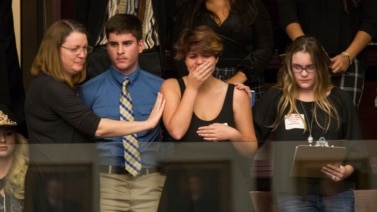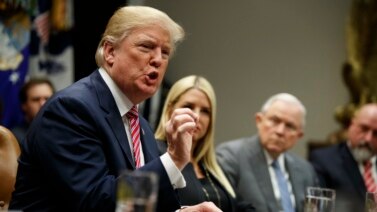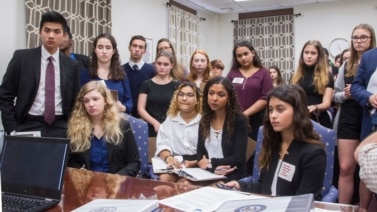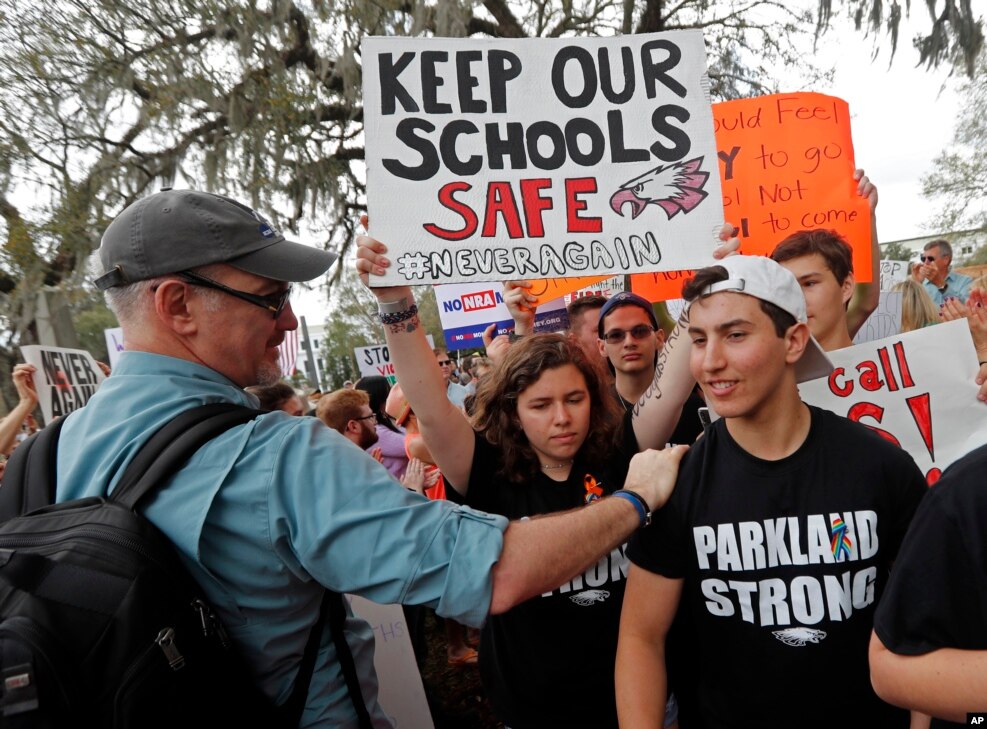
President Donald Trump has called for arming teachers as a way to stop school shootings.
His comments came after the deadly school shooting in Parkland, Florida on February 14. A 19-year-old gunman killed 17 students and teachers at Stoneman Douglas High School. The shooter used an AR-15 semi-automatic rifle that was bought legally.
Since the shooting, Trump has also suggested he may support some new measures to limit guns. One measure would ban anyone under 21 years old from buying a firearm. Another would aim to make it harder for mentally ill people to buy a gun.
Trump took to Twitter to explain his reasoning for wanting to arm teachers. “History shows that a school shooting lasts, on average, 3 minutes. It takes police & first responders approximately 5 to 8 minutes to get to the site of crime. Highly trained, gun adept, teachers/coaches would solve the problem instantly, before police arrive. GREAT DETERRENT!”
....History shows that a school shooting lasts, on average, 3 minutes. It takes police & first responders approximately 5 to 8 minutes to get to site of crime. Highly trained, gun adept, teachers/coaches would solve the problem instantly, before police arrive. GREAT DETERRENT!
— Donald J. Trump (@realDonaldTrump) February 22, 2018
Last week, Trump met at the White House with survivors of the Parkland shooting - as well as state and local officials from Florida - to discuss school safety.
“I think we need hardened sites. We need to let people know, you come into our schools, you’re going to be dead. And it’s going to be fast.”
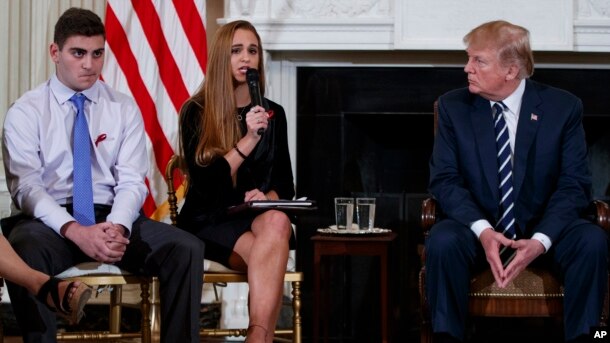
Teachers criticize the proposal
Trump’s proposal to train some teachers to be armed in the classroom was criticized by organizations representing teachers. The National Education Association, or NEA, represents 3 million educators working at U.S. public schools and colleges. Becky Pringle is vice president of the NEA. She is also an eighth grade science teacher.
“I just cringed when I heard the president’s proposal, as did so many educators across this country. I tried to imagine having the responsibility of teaching these children the wonders of science and being held responsible for making life and death decisions with a loaded firearm.”
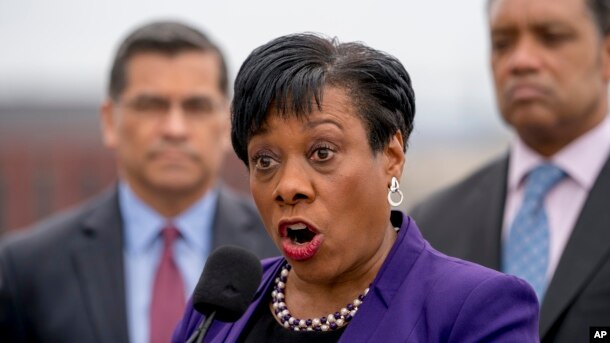
The American Federation of Teachers - which says it represents 1.7 million teachers - also criticized the plan. It said the clear message from its membership - even those who own guns - was that educators “don’t want to be armed, they want to teach.”
The superintendent of Broward County Public Schools - the district where the shooting happened - said he is “totally against arming teachers.” Robert Runcie said educators already have a difficult job and giving them weapons would just make it harder.
Florida’s Republican Governor Rick Scott has also said he opposes the idea of giving guns to teachers. But he did call for increased security at schools, including a plan to put a trained police officer in every Florida school by the start of the fall 2018 school year.
Pringle says she understands the concerns of officials and parents who want to make schools more secure. But she says the NEA supports “common sense gun reform” to help prevent mass shootings. She says Trump and other elected officials who favor armed teachers have not spent enough time with educators and students.
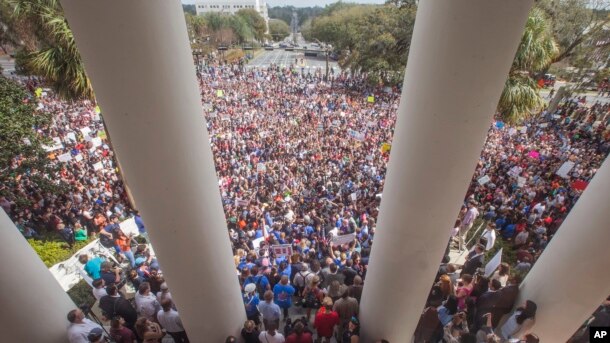
“So this is what we’re doing. And this is what we wish the president would do - and others in positions of power would do, and that is listen to our students. That’s what we’re doing. We’re listening to our students and they are rising up and they’re not backing down and they’re being very clear about what will make them feel safer in schools.”
Pringle was talking about student activists, in Florida and other states, who have responded to the shooting by holding protests and demanding stronger gun laws.
One of those students is Sofia Hidalgo - a 15-year-old student at Albert Einstein High School in the state of Maryland. She joined a demonstration last week in front of the White House. She says the young activists realize that the same kind of tragic shooting could also happen at their schools.

“I think that once we realized that this could happen to us, as well, that it was time for us to make our voices heard to ensure that it never happens again, because this is a serious tragedy.”
Hidalgo says her school has armed police officers and this makes her feel safer. The school also carries out drills to practice how to react to violence and other serious situations. But she does not think arming teachers would help solve the problem.
“By arming the teachers you’re just distributing even more guns. And this is not the solution that we need. We need to be restricting the sales of guns, not increasing them. And by arming the teachers, you’re trying to fight fire with fire and that’s not a solution.”
Some schools already have armed teachers
Several U.S. states already allow teachers to be armed in schools. One of them is Texas. Steve Clugston is the Superintendent of the Callisburg Independent School District, in Callisburg, Texas.
He says one reason the district decided to allow armed teachers was because the area does not have its own police department. This is the case in dozens of school districts in small communities across Texas. If a shooting happens in these areas, Clugston says, police officers likely could not reach the school quickly enough.
Armed teachers must first have a license to carry a handgun in Texas. Educators in the Callisburg district receive training from experts in shooting and gun safety. They also complete drills in the schools on how to react to a variety of live shooter situations.
As he sees it, Clugston said school violence is no different than a situation in which a family is being attacked inside their home.
“Somebody is trying to kick in that door and threatening to kill everybody in that room. At that particular moment, there’s not many people that don’t wish they had a gun to protect themselves at that particular time.”
Clugston says he believes arming teachers works as a deterrent to violence by sending a clear message to would-be attackers. His district places large signs in front of all its school buildings warning that armed teachers and employees are on the property.
“We’re going to use whatever force is necessary to protect our people. When you look at a lot of these active shooters, they tend to target that soft target. We’re going to let them know we’re not a soft target.”
Clugston says the reaction to the district’s program from parents and community members has been “100 percent positive.”
Identify troubled students
In the Parkland, Florida attack, suspected shooter Nikolas Cruz was a former student known by school officials to have a troubled past. The school safety debate has also centered on ways to identify students who could be at risk for future violent behavior.
One group seeking to make a difference is the not-for-profit Educator’s School Safety Network. It offers safety training programs aimed at preventing school violence. Amanda Klinger is director of operations for the organization. She says the group also provides educators with tools to identify, assess and manage certain students who may pose a threat.
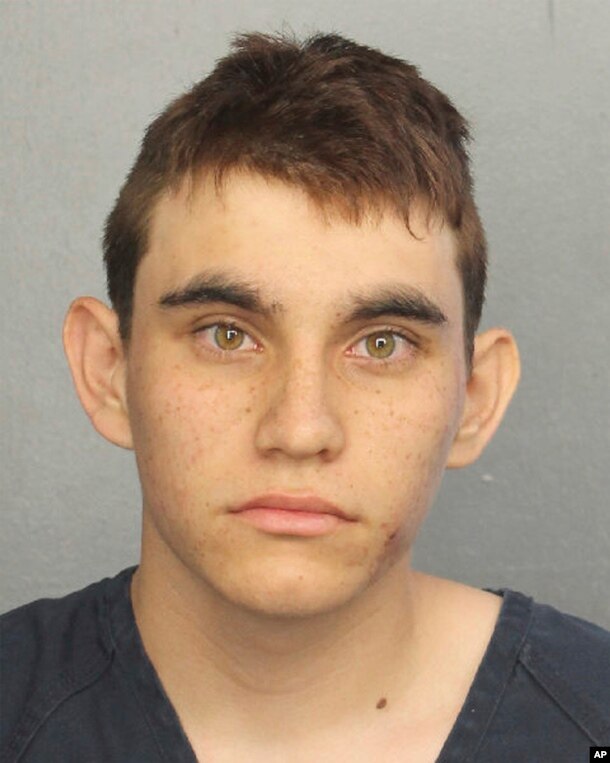
“This is something educators are asking for. Educators aren’t asking to be armed with guns. But they are asking to be armed with education and training and the empowerment to be able to do some of these things to keep kids safe in their schools.”
She added that teachers are often the best people to identify students that could become threats. But many lack the needed skills and tools to effectively do this.
“We have a fact-based investigative approach, where you have a multidisciplinary threat assessment team. And they’re looking at who should we be concerned about? How concerned should we be? And then what are we going to do about it?”
Klinger says her group attempts to arm teachers with the tools to recognize signs of trouble early on, before students begin showing violent behavior. This way, teachers and administrators can decide on the best intervention to prevent future tragedies.
I’m Dorothy Gundy. And I’m Bryan Lynn.
Bryan Lynn reported this story for VOA Learning English. Hai Do was the editor.
We want to hear from you. Write to us in the Comments section, and visit our Facebook page.
Words in This Story
adept - adj. good at doing something
deterrent - n. something that makes someone decide not to do something
cringe - v. feel disgust or embarrassment, sometimes by also showing the feeling by a movement of the face or body
ensure - v. make certain that something is done or happens
drill - n. an exercise done to practice certain skills or procedures
practice - v. to do something again and again in order to become better at it
distribute - v. give or deliver to people
assess - v. make a judgment about (something)
empowerment - n. the process of gaining freedom and power to do what you want or to control what happens
multidisciplinary - adj. involving two or more subject areas

